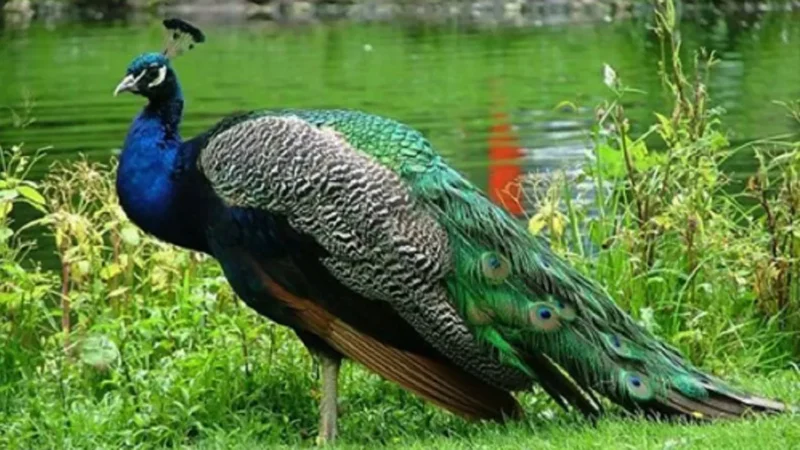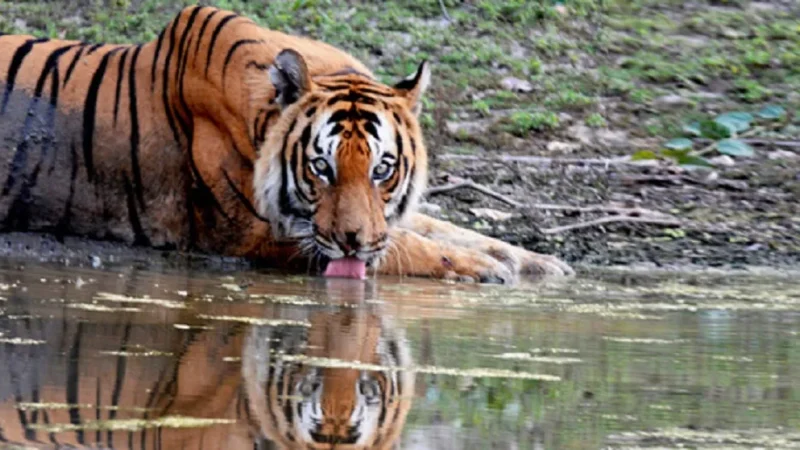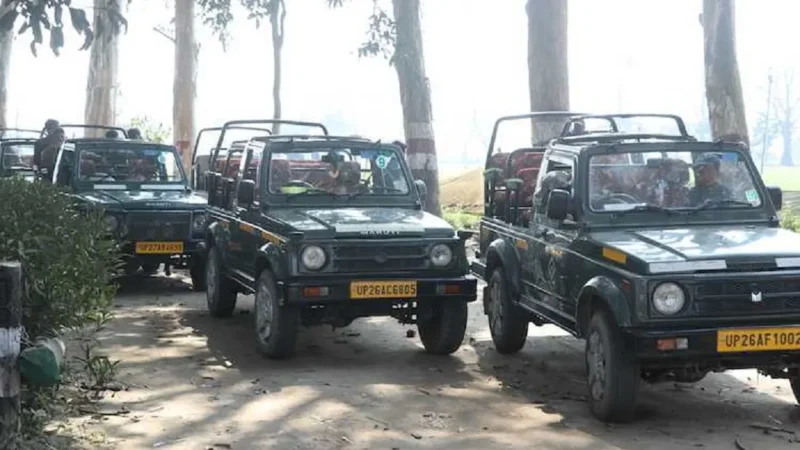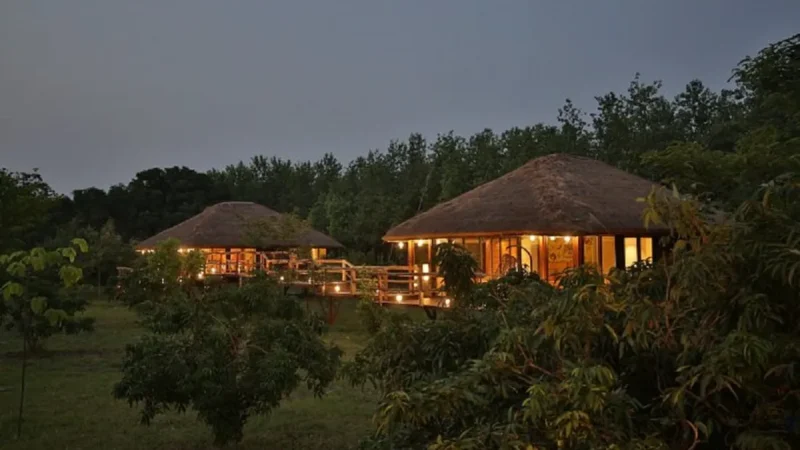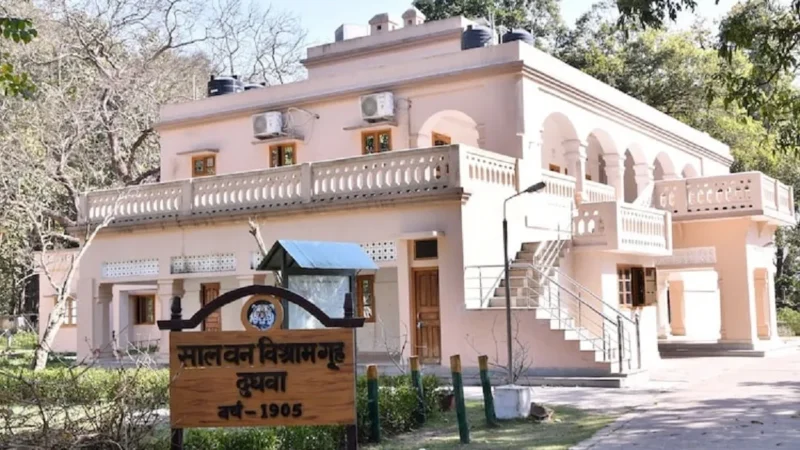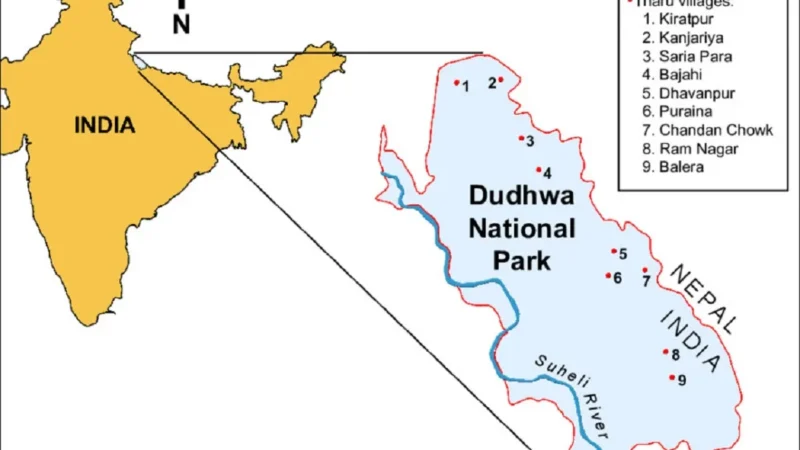Top 15 Wildlife Sanctuary in Uttar Pradesh

Table of Contents
ToggleUttar Pradesh Wildlife Sanctuary -
Welcome to a land where nature’s beauty unfolds in its purest form – Uttar Pradesh, a state not only known for its historical and cultural heritage but also for its hidden treasures of wilderness. Nestled amidst bustling cities and historic landmarks, Uttar Pradesh’s wildlife sanctuaries stand as oases of biodiversity, offering a glimpse into the untamed heart of the region.
In this blog, we discovered the enchanting world of Uttar Pradesh’s wildlife sanctuaries. Often overshadowed by the state’s historical prominence, these sanctuaries hold secrets of diverse ecosystems, rare creatures, and landscapes that inspire awe. From the resounding call of a bird hidden in the dense foliage to the stealthy steps of a predator traversing the forest floor, these sanctuaries weave tales of survival, adaptation, and the delicate balance of life.
Here are the top 15 wildlife sanctuaries of Uttar Pradesh:
1- Dudhwa National Park
Dudhwa National Park is a national park in the Terai region of Uttar Pradesh, India. It is located in the Lakhimpur Kheri and Bahraich districts, and is bordered by Nepal to the east. The park was established in 1977 and covers an area of 490.3 km2 (190.0 sq mi).
Dudhwa National Park is home to a variety of wildlife, including the Royal Bengal tiger, the swamp deer, the Indian rhinoceros, the Gangetic dolphin, the Asian elephant, the gaur, the leopard, the sloth bear, the chital, the sambar, the nilgai, the wild boar, and over 300 species of birds.
The park is a popular tourist destination and offers a variety of activities, including jeep safaris, elephant rides, and bird watching.
2- Pilibhit Tiger Reserve
Pilibhit Tiger Reserve is a tiger reserve and wildlife sanctuary located in Pilibhit district of Uttar Pradesh, India. It is home to various wildlife, including the Royal Bengal tiger, the leopard, the elephant, and the sloth bear.
The reserve was established in 1974 and covers an area of 1,165.46 km2 (449.69 sq mi). It is one of India’s most important tiger reserves and is home to many tigers.
Pilibhit Tiger Reserve is a popular tourist destination and offers a variety of activities, including jeep safaris, elephant rides, and bird watching.
Here are some of the things you can do in Pilibhit Tiger Reserve:
- Take a jeep safari to see the animals.
- Go for a walk or hike in the forest.
- Visit the watchtower for panoramic views of the reserve.
- Go bird watching.
- Visit the Interpretation Centre to learn about the reserve’s history and wildlife.
The entry fee for Pilibhit Tiger Reserve is INR 20 for adults and INR 10 for children. The reserve is open from 6:00 AM to 5:00 PM.
3- Katarniaghat Wildlife Sanctuary
Katarniaghat Wildlife Sanctuary is a protected area in the Upper Gangetic plain, near Bahraich city in Bahraich district of Uttar Pradesh, India. It covers an area of 400.6 km2 (154.7 sq mi) in the Terai of the Bahraich district. In 1987, it was brought under the purview of the ‘Project Tiger’, and together with the Kishanpur Wildlife Sanctuary and the Dudhwa National Park it forms the Dudhwa Tiger Reserve. It was established in 1975.
The Katarniaghat Forest provides strategic connectivity between Dudhwa and Kishanpur tiger habitats in India and the Bardia National Park in Nepal. Its fragile Terai ecosystem comprises a mosaic of sal and teak forests, lush grasslands, numerous swamps and wetlands. It is home to several endangered species, including gharial, tiger, rhino, Gangetic dolphin, swamp deer, hispid hare, Bengal florican, the white-backed and long-billed vultures.
The best time to visit the Katarniaghat Wildlife Sanctuary is during the dry season, from November to April. Due to flooding, the sanctuary is closed during the monsoon season, from June to October.
4- Chandra Prabha Wildlife Sanctuary
Chandra Prabha Wildlife Sanctuary is a wildlife sanctuary located in Chandauli district of Uttar Pradesh, India. It is spread over an area of 78 km² and lies on the Naugarh and Vijaigarh hillocks on the north slope of the Kaimur Range. The Karamnasha River, a tributary of the Ganges, flows through the sanctuary, as does the Chandraprabha River, a tributary of the Karamnasha.
The sanctuary is home to various wildlife, including leopard, sambar, chital, nilgai, wild boar, porcupine, and Indian gazelle. The reptilian inhabitants include gharial and python.
The best time to visit the Chandra Prabha Wildlife Sanctuary is during the dry season, from November to April. Due to flooding, the sanctuary is closed during the monsoon season, from June to October.
5- Kishanpur Wildlife Sanctuary
Kishanpur Wildlife Sanctuary is a part of the Dudhwa Tiger Reserve near Mailani in Uttar Pradesh, India. It covers an area of 227 km2 (88 sq mi) and was founded in 1972.
The sanctuary is covered with a dense deciduous sal, teak and jamun forest. The open meadows dotted with tals and perennial streams attract various animals and birds.
The sanctuary is famous for the swamp deer or Barasingha. It is also home to several other animals, including the tiger, elephant, gaur, leopard, chital, sambar, nilgai, wild boar, and sloth bear. The sanctuary is also home to various birds, including the sarus crane, the painted stork, and the spoonbill.
The best time to visit the Kishanpur Wildlife Sanctuary is during the dry season, from November to April. Due to flooding, the sanctuary is closed during the monsoon season, from June to October.
6- National Chambal Sanctuary
Spanning three Indian states, including Uttar Pradesh, Madhya Pradesh, and Rajasthan, the National Chambal Sanctuary is a unique conservation area that safeguards the rich biodiversity of the Chambal River and its surrounding landscapes. Known for its efforts in protecting critically endangered species, this sanctuary offers a remarkable blend of nature, wildlife, and riverine ecosystems.
Riverine Landscape: The sanctuary is defined by the Chambal River, which flows through rugged terrain, ravines, and sandbanks. Combining these features creates an ideal habitat for diverse flora and fauna.
Critically Endangered Species: One of the sanctuary’s most notable inhabitants is the gharial, a critically endangered crocodile species. The Chambal River remains one of the last strongholds for these unique reptiles. In addition to gharials, the sanctuary is also home to the endangered Indian river dolphin, which is an indicator of the health of the river ecosystem.
Avian Haven: The National Chambal Sanctuary is a haven for birdwatchers. It’s a paradise for various migratory and resident bird species. Species like Indian skimmers, Indian courser, black-bellied tern, and various species of kingfishers can be observed in their natural habitat.
Flora and Fauna: The sanctuary’s ecosystem consists of riverine vegetation, grasslands, and sandy banks. Apart from the gharials and dolphins, it’s also home to mugger crocodiles, turtles, various species of fish, and a variety of terrestrial wildlife including nilgai, sambar deer, and wild boars.
7- Mahavir Swami Wildlife Sanctuary
Mahavir Swami Wildlife Sanctuary is a wildlife sanctuary located in Lalitpur district of Uttar Pradesh, India. It is spread over an area of 5.4 km2 (2.1 sq mi). The sanctuary is named after Mahavir Swami, a Jain monk said to have attained enlightenment here.
The sanctuary is home to various wildlife, including leopard, nilgai, wild boar, sambhar, chinkara, wolf, hyena, and various birds. It is also home to several reptiles, including the mugger crocodile and the python.
The best time to visit the Mahavir Swami Wildlife Sanctuary is during the dry season, from November to April. Due to flooding, the sanctuary is closed during the monsoon season, from June to October.
8- Soor Sarovar Bird Sanctuary
Soor Sarovar Bird Sanctuary is a bird sanctuary in Agra, Uttar Pradesh, India. It is spread over 1000 hectares and is home to over 200 species of birds. The sanctuary is a popular tourist destination known for its bird watching opportunities.
The sanctuary is home to various birds, including flamingos, pelicans, herons, ibises, storks, ducks, geese, and waders. The sanctuary is also home to several other animals, including deer, monkeys, and reptiles.
The best time to visit the sanctuary is from November to February in the winter. This is when the sanctuary is home to the largest number of birds. The sanctuary is open from sunrise to sunset.
9- Lakh Bahosi Bird Sanctuary
Lakh Bahosi Bird Sanctuary is a bird sanctuary located in Kannauj district of Uttar Pradesh, India. It is spread over 80 square kilometers (31 sq mi) and is home to over 49 species of birds, including pelicans, herons, ibises, storks, ducks, geese, and waders. The sanctuary is also home to several other animals, including deer, monkeys, and reptiles.
The best time to visit the sanctuary is from November to February in the winter. This is when the sanctuary is home to the most significant number of birds. The sanctuary is open from sunrise to sunset.
10- Kachhua Sanctuary
Kachhua Sanctuary is a wildlife sanctuary in Varanasi, Uttar Pradesh, India. It is spread over 850 hectares and is located in the Ganges River. It is home to various turtles, including the Indian flapshell turtle, the hardshell turtle, and the gharial. It also has a variety of other animals, including the chital, nilgai, and sambar.
The Kachhua Sanctuary was established in 1989 to conserve turtles and other animals. It has several programs, including a program to reintroduce turtles to their natural habitats.
The Kachhua Sanctuary is a popular tourist destination. It has several programs, including turtle watching and educational programs about turtles and other animals.
11- Samaspur Bird Sanctuary
Samaspur Bird Sanctuary is a protected area near Salon in Raebareli district, Uttar Pradesh, India, about 122 km from Lucknow on Lucknow-Varanasi highway. It was established in 1987 on about 780 hectares of land. The nearest railway station is Unchahar and the nearest airport is Fursatganj. More than 250 varieties of birds can be seen there, some of which travel more than 5000 km to get there, including the greylag goose, pintail, common teal, Eurasian wigeon, northern shoveler, and ruddy shelduck (Surkhab).
Local birds include the knob-billed duck, lesser whistling-duck, Indian spot-billed duck, Eurasian spoonbill, kingfishers, and vultures. There are twelve varieties of fish in the lake at Samaspur.
The sanctuary is a Ramsar site, which means it is an internationally important wetland. It is also a designated Important Bird Area (IBA) by BirdLife International.
The best time to visit the Samaspur Bird Sanctuary is during the winter, from November to February. This is when the sanctuary is home to the largest number of birds. The sanctuary is open from sunrise to sunset.
12- Bakhira Bird Sanctuary
Bakhira Bird Sanctuary is a Ramsar site in Sant Kabir Nagar district of Uttar Pradesh, India. It is a large natural wetland, covering an area of 29 square kilometers. The sanctuary was established in 1980 and is home to over 80 species of birds, including the bar-headed goose, common crane, Eurasian spoonbill, and ruddy shelduck.
The sanctuary is also home to various animals, including the blackbuck, nilgai, and wild boar.
The best time to visit the Bakhira Bird Sanctuary is during the winter, from November to February. This is when the sanctuary is home to the largest number of birds. The sanctuary is open from sunrise to sunset.
13- Sohagi Barwa Wildlife Sanctuary
Sohagi Barwa Wildlife Sanctuary is located in the Maharajganj district of Uttar Pradesh, India. It is spread over 428.2 km², located on the west Bank of the Gandaki River, near the border with Nepal. Sohagi Barwa is one of the tiger habitats in Uttar Pradesh. SBWS is divided into seven forest ranges: Pakdi, Madhwaliya, Laxmipur, North Chouk, South Chouk, Seopur and Nichlaul ranges with 21 grasslands. The sanctuary is home to diverse flora and fauna, including tigers.
The main attraction of Sohagi Barwa Wildlife Sanctuary is the tiger. Other animals found in the sanctuary include leopard, cheetal, bear, Indian Civet, Giant Squirrel, Hare, wild cat, wild boar, Monitor Lizard, Neelgai, and Indian python. There are seven rest houses in the sanctuary.
The best time to visit the Sohagi Barwa Wildlife Sanctuary is during the winter, from November to February. This is when the sanctuary is home to the largest number of tigers. The sanctuary is open from sunrise to sunset.
14- Tikonia Wildlife Sanctuary
Tikonia Wildlife Sanctuary is a small wildlife sanctuary in Haldwani, Uttar Pradesh, India. It is spread over an area of 5.4 square kilometers. The sanctuary was established in 1994 and is home to a variety of animals, including leopard, nilgai, wild boar, sambhar, chinkara, wolf, hyena, and a variety of birds.
The sanctuary is particularly known for its leopards, elephants, deers, and gaur also known as Indian Bison. Viewing wild animals from the Devil’s Canon View Point is more convenient.
The best time to visit the Tikonia Wildlife Sanctuary is during the dry season, from November to April. Due to flooding, the sanctuary is closed during the monsoon season, from June to October.
15- Ranipur Wildlife Sanctuary
The Ranipur Wildlife Sanctuary is located in the Chitrakoot district of Uttar Pradesh, India. It is spread over an area of 230 square kilometers. The sanctuary was established in 1977 and is home to a variety of animals, including tigers, leopards, sloth bears, sambars, blackbucks, peafowl, spur fowl, jungle fowl, painted partridges,kingfisher,sparrow, fishing cats and chinkaras.
The sanctuary is bounded by two important rivers, the Betwa and the Dhasan, which flow through the region and provide a source of water for the wildlife in the reserve.
The best time to visit the Ranipur Wildlife Sanctuary is during the dry season, from November to April. Due to flooding, the sanctuary is closed during the monsoon season, from June to October.
Here are some of the things you can do in the Ranipur Wildlife Sanctuary:
- Take a jeep safari to see the animals.
- Go for a walk or hike in the sanctuary
- Visit the watchtower for panoramic views of the sanctuary
- Visit the Interpretation Centre to learn about the sanctuary’s history and wildlife.
The entry fee for Ranipur Wildlife Sanctuary is INR 50 for adults and INR 25 for children. The sanctuary is open from 6:00 AM to 5:00 PM.

